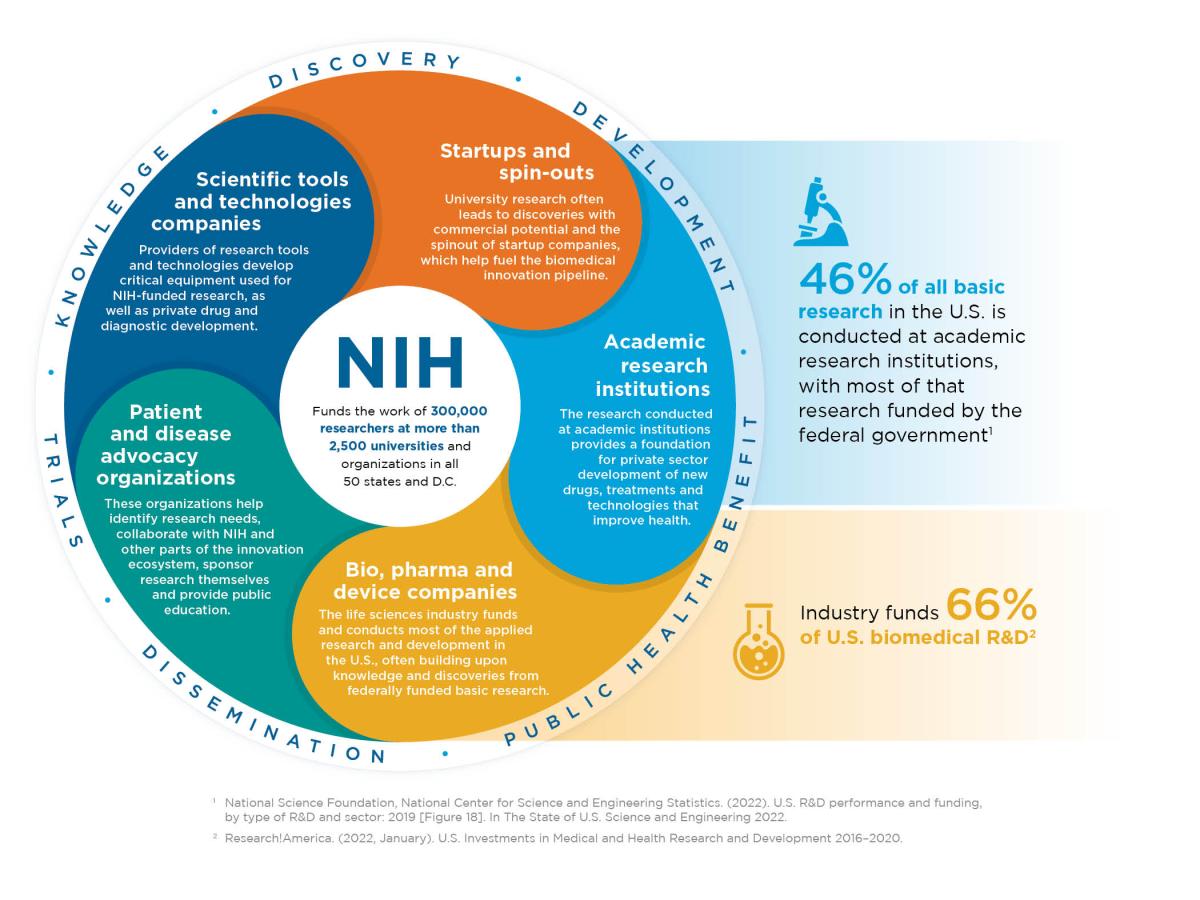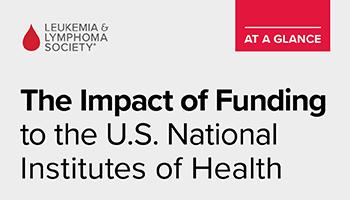Balancing Fiscal Responsibility with Saving and Improving Lives
In the coming months, we expect important conversations to continue about stewardship of federal dollars aimed at medical research through the National Institutes of Health (NIH) as well as about access to affordable healthcare. The Leukemia & Lymphoma Society (LLS) is monitoring these situations closely to determine how the decisions being made will affect blood cancer research and patient care, and we’re engaging where we see a critical need to act.
As a nonprofit dedicated to improving the lives of blood cancer patients and their families, LLS is laser focused on spending its own resources wisely. While federal dollars are on a much larger scale, the questions are the same ones LLS faces every day. What are we trying to accomplish with the funding? Is the funding furthering the mission? Is our spending efficient and effective?
In this and future blogs, we will provide the answers to questions like these that influence our approach to national policy issues affecting blood cancer patients and their families.
The LLS Bold Goal: Accelerate Progress in Blood Cancer
In February 2025, LLS announced a bold new goal: enable blood cancer patients to gain more than one million years of life by 2040. Our bold goal means more birthdays, more graduations, and more cherished moments for blood cancer patients and their families. LLS stands ready to accelerate cures and treatments, and to improve patient access to them to get us there, but cuts to NIH and other research funding will slow progress.
We know you have access to information from many sources, and that your email inbox is inundated. Our goal is to provide a detailed and balanced analysis of the issues that matter to LLS because they matter to patients. They also will affect our ability to achieve our Bold Goal.
LLS’s role in policy discussions that impact research and access to treatment
LLS has a long history among policymakers both in Washington, D.C. and state capitals as a respected bipartisan facilitator of complex policy discussions. We rely on our reputation and experience to make sure blood cancer patients have a voice as new policies and priorities are being proposed and debated.
There are times when there are immediate threats to patients and our mission. During these moments we raise our voice loudly (read our recent statement on research funding cuts).
Policy decisions influence cancer care progress—including patient survival and quality of life, as well as new treatment innovations—and that influence lasts for decades. That’s why LLS is so invested in the policy arena and committed to keeping you informed.
What we’re currently talking about: NIH research funding cuts
The United States is the world leader in cancer drug discovery, innovation in biotechnology, and improving cancer care. U.S. dominance of this industry is not by chance. It has been driven by robust and consistent investment in NIH; partnership and investment from research universities, biotech and pharma companies; and expertise and funding from patient advocacy groups including LLS
A Unique U.S. Public-Private Consortium Drives U.S. Dominance in Research and Biotechnology

The Administration has attempted to make an immediate, $4 billion cut to already-committed funding from the NIH for life-saving research. These cuts will be amplified as they are carried forward in future NIH budgets, changing the landscape of cancer care for generations.
These cuts would be a fundamental disruption to the entire biomedical research innovation ecosystem and will weaken our infrastructure for scientific discovery. This infrastructure underpins U.S. dominance in biomedical research and our ability to bring new treatments to patients.
Some arguments for the proposed cuts paint academic research institutions, the main recipient of NIH funds, as bloated or worse, fraudulent. While it is sensible to review large expenditures regularly, it is vital to understand the role of NIH, how and why it funds research the way it does, and what decades of robust and regular investment have meant to patients and our place as the international leader in medical advancements. NIH funding is doing exactly what it was intended to do—make our nation stronger and healthier.
The Vision for NIH: An 80+ Year Legacy
In 1940, when dedicating Building 1 at the NIH, FDR said, "We cannot be a strong nation unless we are a healthy nation. We must recruit not only men and materials, but also knowledge and science in service of national strength. We seek the same partnership that we seek for industrial production."
He compared the growth of science and medicine to the growth of manufacturing, industrialization, technology, agriculture, and other sectors. For each, he saw a fundamental responsibility of the government in the free-market economy to provide conditions for growth that the market cannot efficiently create on its own.
Below we provide the LLS perspective, based on a conversation with LLS President and CEO E. Anders Kolb, M.D., on the biomedical research ecosystem and how LLS can influence the best outcome for patients and progress.
NIH was designed to foster fundamental creative discoveries and innovative medical research. Equally importantly, NIH was designed to develop, maintain, and renew scientific, human, and physical resources. To do this, NIH does not just fund labs exclusively through direct grants but also through indirect grants that contribute to the underlying infrastructure that allows those labs and the best scientific minds to flourish. The result is a high rate of return form the American economy and the American people.
The NIH Mission and Goals Support the Nation's Health and Economic Well-being
- Foster fundamental creative discoveries, innovative research strategies, and their applications as a basis for ultimately protecting and improving health.
- Develop, maintain, and renew scientific human and physical resources that will ensure the Nation's capability to prevent disease.
- Expand the knowledge base in medical and associated sciences to enhance the Nation's economic well-being and ensure a continued high return on the public investment in research.
- Exemplify and promote the highest level of scientific integrity, public accountability, and social responsibility in the conduct of science.
Academia is an invaluable partner in U.S. medical success
Academic institutions provide the rich soil where new ideas germinate and develop, and where scientists thrive. To maintain these enriched environments for innovation, institutions receive a percentage of every research project grant to support Facilities and Administrative (F&A) costs, or “indirect costs.”
The proposed $4 billion in cuts will primarily affect the F&A dollars institutions receive. “We should be careful not to dismiss these critical investments simply as ‘overhead,” says Dr. Kolb. “Globally competitive, innovative research requires personnel, instruments, computing, and facilities that cost far more than the grant amounts awarded by the NIH.”
“Academic institutions have been criticized as abusers of F&A dollars.” says Dr. Kolb. “In truth, F&A dollars fuel the pace of progress at academic institutions, and academic institutions feed the ideas, people and innovation that fuel the world-leading US Biotech industry.” They also share in the cost.
Inflation tracking shows that the cost of doing research has increased significantly, yet the NIH inflation-adjusted budget has remained flat. According to the Biomedical R&D Price Index, research costs have increased faster than general inflation, about 23.5% from 2010 to 2020.
“The assumption that there is waste in the system simply doesn’t add up,” says Dr. Kolb. “Even as prices have risen considerably and funding has remained flat, the pace of discovery in the U.S. is at an all-time high. This would not be possible if funds were being squandered.”
“Costs can spiral, and it is reasonable to trim where possible. This is a hallmark of how we operate at LLS and it’s a good policy for government funding, too. Nonetheless, we have to recognize that decades of American leadership in cancer biotech and medicines are clear evidence that the F&A dollars are largely well spent and distributed.”
LLS’s role in the U.S. research innovation ecosystem
As the largest nonprofit funder of blood cancer research, LLS is not dependent on federal funding. LLS makes independent decisions that provide critical funding for some of the most compelling projects and people in blood cancer research.
LLS, like most nonprofit funders of biomedical research, includes both direct and indirect funds in its grants. In fact, the lower maximum indirect rate from philanthropic funding organizations like LLS (usually capped at 15%) was cited in the announcement of the sudden NIH cuts.
“To suggest that the maximum rate provided by a private foundation or a public charity, whose investment is just a small fraction of government funds, should set the rate for the federal government ignores the macroeconomic benefit to America,” says Dr. Kolb. “If we are to remain the world leader in healthcare, the NIH must continue to be the global leader driving progress and certainty in the biomedical and biotech sectors. The sustained and profound return for the American people far exceeds the NIH investment."
Proof of progress: Research investment changes lives
Since 1960, innovation in blood cancer treatment has added more than 20 million years of life for individual Americans, for the benefit of individuals, families, culture, society, and the economy. This was driven by the unique U.S. public-private-non-profit partnership model.
LLS has identified great research ideas early and invested billions of dollars since 1949. The NIH, and its crown jewel, the National Cancer Institute (NCI), have made major contributions by creating an unparalleled capacity for scientific discovery in academic labs in states across the country. And those labs—incubators of scientific development—have been on the frontlines of groundbreaking discoveries.
When the science reaches the right stage, the U.S. biotechnology and pharmaceutical sectors are there to make the next big investments.
“The current Administration sees an opportunity to improve our efficiencies in research spending and infrastructure. Few in academia, me included, would shy away from this discussion,” says Dr. Kolb, “but this must be accomplished through thoughtful investment, not arbitrary cuts.”
What LLS is doing
Our dedicated teams in the LLS Office of Public Policy as well as our patient and community outreach professionals are embedded in communities across the country, connecting with patients and advocating before lawmakers.
LLS scientists are connecting with partners and collaborators around the country to ensure that LLS dollars can have a maximal effect on progress for cancer patients.
Help LLS bring support to those who need it most
Join LLS in taking action for patients! Visit LLS’s website to stay informed, to drive research forward, and to send a message to your members of Congress.
With your commitment, we will build on LLS’s long legacy of being a voice for patients and ensuring people facing blood cancer get the treatment and support they need.

